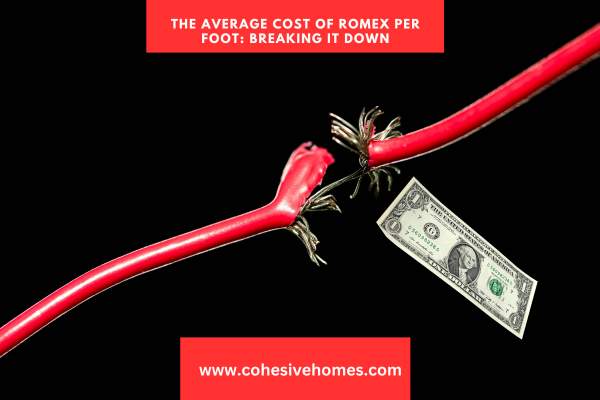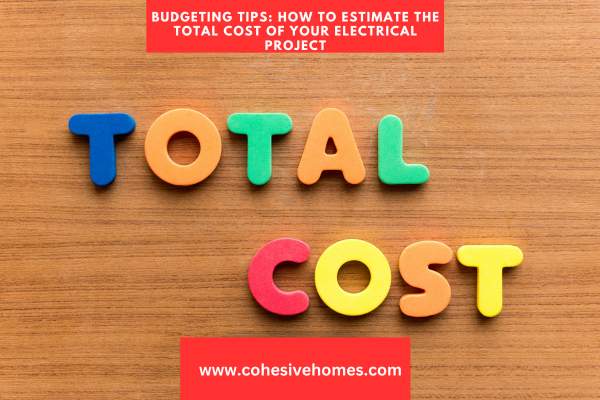Hey there, fellow DIY enthusiasts! Are you embarking on an electrifying project at home and finding yourself in a bit of a wire-y situation? Well, fear not, because we’re here to shed some light on a common question. How much does Romex cost per foot?
Whether you’re a seasoned handyman or a curious novice, understanding the price of this popular electrical wire can help you plan your budget and ensure you have the right materials for your next endeavor.
So, grab your wire strippers and get ready to dive into the world of Romex pricing in this informative and conversational blog post!
What is Romex and Why is it Popular?

If you’ve ever embarked on an electrical project, chances are you’ve come across the term “Romex.”
But what exactly is Romex, and why is it so popular among electricians, contractors, and DIY enthusiasts alike?
Romex, a brand name for Non-Metallic Sheathed Cable (NM cable), offers a type of electrical cable widely used for various applications.
It consists of multiple insulated conductors (wires) encased in a flexible plastic jacket, typically made of PVC (polyvinyl chloride). The conductors within Romex are typically copper, which is known for its excellent conductivity and durability.
So, what sets Romex apart from other types of electrical wiring? One of the main reasons for its popularity is its versatility and ease of installation.
Romex simplifies residential electrical wiring by combining multiple wires in a single jacket.
This feature not only saves time but also reduces the risk of tangled wires and potential confusion during installation.
Additionally, Romex is highly regarded for its safety features.
The plastic jacket acts as a protective barrier, preventing the conductors from being accidentally damaged or creating hazards.
This makes Romex a reliable choice for applications where the wires need to be concealed within walls, ceilings, or floors.
Another reason behind Romex’s popularity is its compliance with electrical codes and regulations.
Romex is approved by the National Electrical Code (NEC) in the United States, which sets the standards for electrical installations.
Its compliance ensures that Romex meets safety requirements and can be used with confidence in residential and commercial settings.
Moreover, Romex is widely available at hardware stores, home improvement centers, and online retailers.
Its accessibility, combined with its reputation for reliability, has made it a go-to choice for both professionals and DIY enthusiasts.
Understanding Romex Wire Types and Sizes

When it comes to electrical projects, choosing the right wire is crucial for a safe and efficient installation.
Romex, a popular brand of Non-Metallic Sheathed Cable (NM cable), comes in various types and sizes to accommodate different electrical applications.
Let’s explore the different Romex wire types and sizes to help you make informed decisions for your next project.
Romex Wire Types
NMB, the most common Romex wire type, is ideal for general residential wiring applications.. It consists of two or more insulated conductors and a bare copper grounding wire, all enclosed within a PVC jacket.
UF-B (Underground Feeder Cable): UF-B Romex is specifically designed for underground installations. It is moisture-resistant and can be buried directly in the ground without the need for conduit. UF-B Romex is often used for outdoor lighting, garage wiring, and underground circuits.
NM-B (Non-Metallic Sheathed Cable with Ground): NM-B Romex is similar to NMB Romex but includes a grounding wire in addition to the insulated conductors. This grounding wire provides an additional safety measure, reducing the risk of electrical shocks and ensuring compliance with electrical codes.
Romex Wire Sizes
Romex wires are categorized based on their gauge or wire size. The wire size refers to the diameter of the conductors within the cable. The most common Romex wire sizes for residential applications include:
- 14 AWG: This wire size is commonly used for lighting fixtures and general household outlets with a 15-amp circuit.
- 12 AWG: This wire size is suitable for most household outlets and appliances that require a 20-amp circuit.
- 10 AWG: This thicker wire size is used for larger appliances, such as air conditioners, electric stoves, or electric water heaters, which require a 30-amp circuit.
It’s important to note that the specific wire size required for your project depends on the electrical load, circuit amperage, and local electrical codes. Always consult the NEC or a qualified electrician to determine the appropriate wire size for your specific application.
The Average Cost of Romex per Foot: Breaking It Down

If you’re planning an electrical project, it’s important to have a clear understanding of the average cost of Romex per foot.
Having this information allows you to estimate your budget accurately and make informed purchasing decisions.
Let’s break down the average cost of Romex per foot and explore the factors that can influence the pricing.
On average, Romex can range in price from around $0.20 to $1.00 per foot, depending on various factors such as wire type, wire size, and location.
Here’s a breakdown of these factors and their impact on the cost:
Wire Type
NMB (Non-Metallic Sheathed Cable): NMB Romex, the standard type for residential wiring, is generally more affordable, falling within the lower end of the price range.
UF-B (Underground Feeder Cable): UF-B Romex, designed for underground installations, tends to be slightly more expensive due to its specialized features and increased durability.
NM-B (Non-Metallic Sheathed Cable with Ground): NM-B Romex, which includes a grounding wire for added safety, may have a slightly higher price compared to NMB Romex.
Wire Size
The wire size, measured in gauge (AWG), affects the cost. Thicker wires with larger gauge numbers, such as 10 AWG, tend to be more expensive per foot than thinner wires like 14 AWG or 12 AWG. This price difference is due to the increased amount of copper used in thicker wires.
Location and Retailer
The cost of Romex can vary depending on your geographical location and the retailer you choose. Prices might differ between brick-and-mortar stores, online retailers, or local suppliers. Consider exploring multiple options to find the best price available in your area.
Quantity and Length
Purchasing Romex in bulk or larger quantities can often lead to discounts, reducing the average cost per foot. However, it’s essential to calculate the required length accurately to avoid unnecessary expenses from purchasing excess Romex.
It’s important to note that the prices mentioned here are average estimates and can vary based on the factors mentioned above, as well as market conditions and other variables.
Always check with local suppliers or retailers for the most up-to-date pricing information.
While cost is a crucial consideration, prioritize safety, compliance with electrical codes, and the specific requirements of your project when selecting Romex.
It’s advisable to consult a qualified electrician or seek professional guidance if you have any doubts or questions about your wiring needs.
Budgeting Tips: How to Estimate the Total Cost of Your Electrical Project

Planning and budgeting for an electrical project can be a daunting task, especially when it comes to estimating the total cost.
To help you stay on track and avoid any financial shocks along the way, here are some valuable budgeting tips to help you estimate the total cost of your electrical project more effectively:
| Budgeting Tips | Description |
| Define the Scope of Your Project | Clearly define the tasks and goals of your electrical project to accurately assess the materials and labor required. |
| Create a Detailed Project Plan | Break down your project into components and create a detailed plan, listing materials, tools, permits, and other necessary elements. |
| Research Material Costs | Research the costs of electrical materials such as Romex, outlets, switches, and circuit breakers, and compare prices from different suppliers. |
| Account for Labor Costs | Consider labor costs if you’re hiring a professional electrician, or estimate the time required if you’re doing the project yourself. |
| Factor in Permit Fees and Inspections | Determine the permit fees and inspection costs associated with your project and include them in your budget. |
| Consider Miscellaneous Expenses | Account for miscellaneous expenses like unexpected repairs, additional tools, safety gear, or any other incidentals that may be necessary. |
| Seek Professional Advice | Consult a professional electrician or contractor for guidance and insights to refine your estimates and make cost-effective choices. |
| Set Aside a Contingency Fund | Allocate a contingency fund of 10% to 15% of the estimated project cost to cover unforeseen expenses or changes that may arise during the project. |
Where to Buy Romex and Finding the Best Deals

Here are some common places where you can buy Romex and tips for finding the best deals:
Local Hardware Stores and Home Improvement Centers
Local hardware stores and home improvement centers are convenient options for purchasing Romex. Visit stores like Home Depot, Lowe’s, or Ace Hardware, as they typically have a wide selection of electrical materials, including Romex.
Check their websites or call ahead to inquire about product availability and pricing. Some stores may also offer online ordering with in-store pickup or delivery options.
Electrical Supply Stores
Electrical supply stores specialize in providing a wide range of electrical materials, including Romex. These stores often have knowledgeable staff who can assist you in finding the right type and size of Romex for your project.
Look for local electrical supply stores in your area, as they may have competitive prices and a broader selection compared to general hardware stores.
Online Retailers
Online retailers like Amazon, eBay, and electrical supply websites offer the convenience of shopping from the comfort of your home. They often have a vast inventory of Romex, allowing you to compare prices, read customer reviews, and access a wider range of options.
Be sure to verify the seller’s reputation and check for any shipping costs or delivery timeframes. Read product descriptions carefully to ensure you are purchasing the correct type and size of Romex.
Local Electrical Contractors and Electricians
Reach out to local electrical contractors or electricians to inquire if they sell Romex directly. Some professionals may be willing to sell materials at a competitive price, especially if you’re hiring them for your project.
It’s essential to ensure that the Romex they offer is genuine and meets the required standards and codes.
Conclusion

Purchasing Romex for your electrical project doesn’t have to be a daunting task, thanks to the variety of options available on the market.
Whether you choose to buy from local hardware stores, home improvement centers, electrical supply stores, online retailers, or even directly from electrical professionals, finding the right Romex for your needs is within reach.
To ensure you get the best deals on Romex, it’s important to compare prices, consider bulk purchases for larger projects, and keep an eye out for sales, discounts, or clearance items.
Additionally, seeking advice from professionals and verifying the authenticity and compliance of the Romex you purchase are essential for a successful and safe electrical installation.
Remember, while cost is a significant factor, quality, safety, and adherence to electrical codes should always be prioritized.
A reliable and efficient electrical system is crucial for the well-being and functionality of your project.
By taking the time to research and explore different purchasing options, you can find the best deals on Romex without compromising on the quality and integrity of your electrical project.
So, go ahead, plan your project, estimate your budget, and embark on your electrical endeavor with confidence, knowing that you have made informed choices regarding the purchase of Romex.
FAQS
Where can I buy Romex?
Romex is available at hardware stores, home improvement centers, electrical supply stores, and online retailers.
How can I ensure the Romex meets the required standards and codes?
Look for reputable brands, check for certifications like UL listings, and consult local building codes or a professional electrician for guidance.
Are there any ways to save money when buying Romex?
Compare prices, look for discounts or promotions, consider purchasing in bulk for larger projects, and check for clearance or overstock items.
